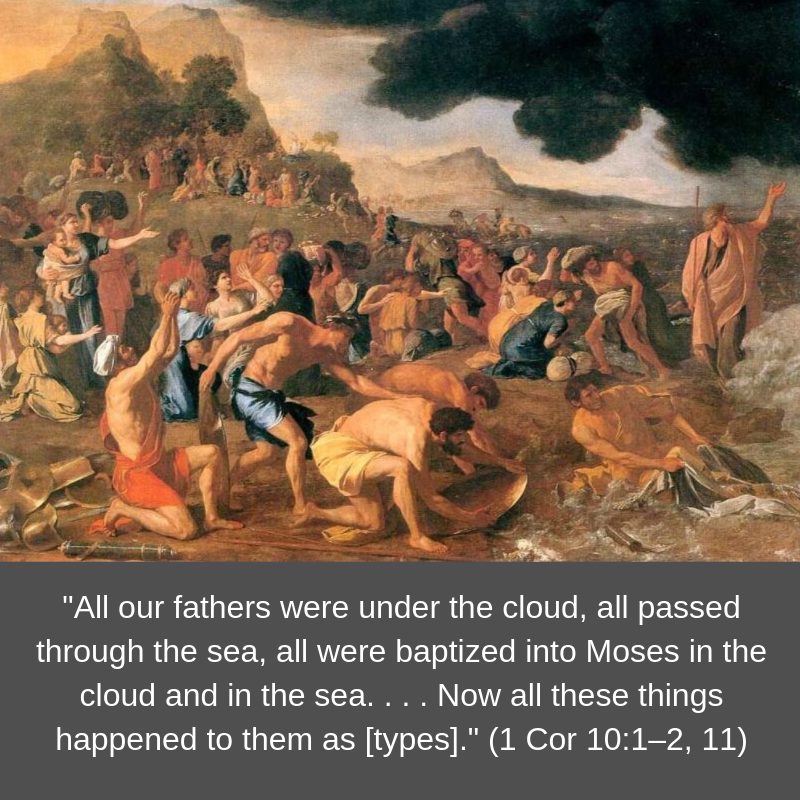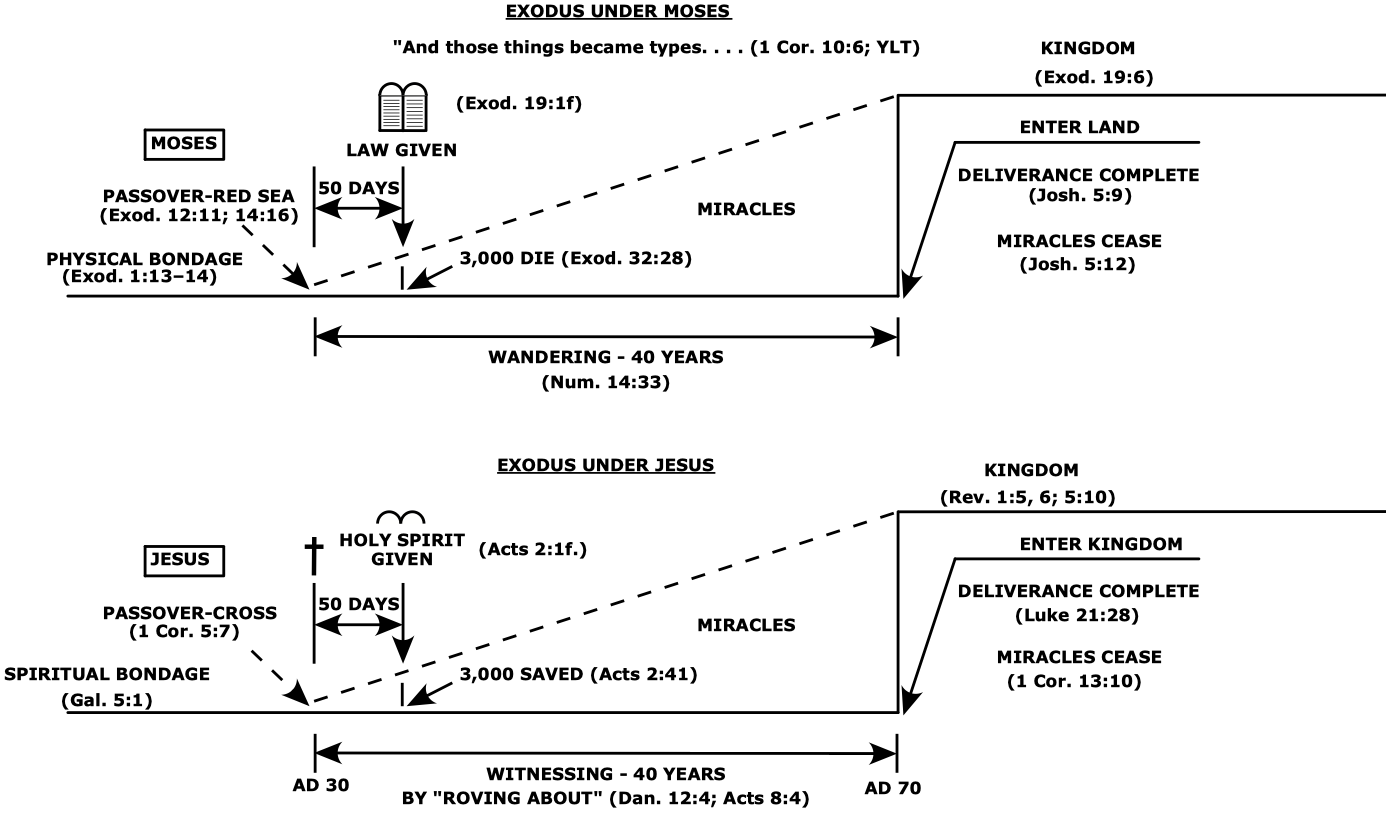
Our most recent five posts1 have considered the cessation of supernatural gifts. They are no longer an ongoing, day-to-day reality in the church’s experience. We will now return to our series of Meditations in Matthew.
Our last two posts in that series dealt with Matthew 27–28. One (here) showed how Jesus rebuilt the Temple. Another discussed how he redefined Israel (here). These accomplishments—a new Temple and a new Israel—were radical transformations in the traditional Jewish thought of Jesus’s generation.
In this post, we will consider another transformation Jesus accomplished. His death, burial, and resurrection (Matt 27:32–28:10) comprised a new exodus.
We have direct scriptural authority to use this term. Luke tells us Jesus
took Peter, John, and James and went up on the mountain to pray. As He prayed, the appearance of His face was altered, and His robe became white and glistening. And behold, two men talked with Him, who were Moses and Elijah, who appeared in glory and spoke of His decease (Gk. exodus) which He was about to accomplish at Jerusalem. (Luke 9:28–31)
Some translations recognize the word exodus in the Greek text of Luke 9:31. One says, “They talked over his exodus.”2 Another has, “they were speaking about his exodus from this world, which was about to be fulfilled in Jerusalem.”3
Commentators also recognize Jesus’s death, burial, and resurrection as his exodus. Regarding Luke 9:31, one says:
The term “departure” is exodos. This can refer to (1) Jesus’ death. This interpretation is supported by the following statement “which he was about to bring to fulfillment at Jerusalem” (cf. Luke 13:33; 2 Pet 1:15; cf. also Wis 3:2; 7:6). (2) His death and resurrection. This is supported by the passion prediction in Luke 9:22, which mentions both Jesus’ death and resurrection. (3) His death, resurrection, and ascension. Luke 9:51 and perhaps also Luke 24:26 favor this, although the latter may also be understood in light of the second interpretation. It seems probable that the most inclusive interpretation (3) is the correct one.4
The New Testament also shows the exodus from Egypt under Moses was a picture (or type) of Jesus’s exodus.5 Moses’s exodus was a symbol; Jesus’s exodus was the reality. Paul said,
I do not wish you to be ignorant, brethren, that all our fathers were under the cloud, and all passed through the sea, and all to Moses were baptized in the cloud, and in the sea.… And those things became types of us.… And all these things as types did happen to those persons… (1 Cor 10:1–2, 6, 11 YLT; emphasis added).
Peter W. L. Walker recognizes this typology. He says, “There is a parallel between Jesus’ work of redemption in Jerusalem and Moses’ work of redemption from Egypt.”6
The Scriptures compare Jesus’s exodus to that of Moses in at least three ways: as an individual redemption, as a corporate redemption, and as an age-changing redemption.
Individual Redemption
Many Scriptures describe Moses’s exodus as the redemption of individuals. God gave laws that regulated the servitude of Israelites. He said, “They are My servants, whom I have brought out from the land of Egypt: they are not sold with the sale of a servant” (Lev 25:42). The exodus under Moses secured rights for these individuals.
The Scriptures also apply the benefits of Christ’s exodus to individuals. For example, Paul says:
I have been crucified with Christ; it is no longer I who live, but Christ lives in me; and the life which I now live in the flesh I live by faith in the Son of God, who loved me and gave Himself for me. (Gal 2:20)
Paul said Christ’s exodus redeemed him as an individual. All individual Christians can say the same.
Corporate Redemption
Moses’s (typical) exodus was also a corporate event that affected all Israelites of all time. Speaking to the second generation of Israelites, Moses said, “You shall remember that you were a slave in the land of Egypt, and the LORD your God redeemed you; therefore I command you this today” (Deut 15:15). Most of the individuals to whom Moses spoke had never been slaves in Egypt. But they were part of the nation of Israel. So, Moses could speak this way.
About eight centuries later, God said, “I brought you up from the land of Egypt and redeemed you from the house of slavery, and I sent before you Moses, Aaron, and Miriam” (Mic 6:4; emphasis added). These individuals to whom God spoke had never been in Egyptian bondage. Still, that bondage and the exodus from it were part of their national experience. So, God applied the exodus redemption to them as individuals.
We can generalize. The exodus under Moses redeemed “Israel after the flesh” (1 Cor 10:18 KJV) as a corporate body. Any person who became an Israelite, either by birth or by proselyte circumcision (e.g., Exod 12:48), inherited its redemptive benefits. The time during which a person lived was irrelevant.
The same is true of Jesus’s (antitypical) exodus. His was a corporate redemption. Many New Testament Scriptures show this is true. For example, Paul said, “Christ redeemed us from the curse of the law by becoming a curse for us—for it is written, ‘Cursed is everyone who is hanged on a tree’” (Gal 3:13). When Jesus hung on the cross, so did all his people.
Jesus secured an actual redemption of men from spiritual bondage to sin. When Jesus accomplished his exodus, he redeemed all individuals in the “Israel of God” (Gal 6:16). People become spiritual Israelites not by physical birth, but by being “born again” by the Spirit of God (John 3:3). This new birth and the blessings of Jesus’s exodus go together.
These newborn spiritual babes desire the milk of the Word (1 Pet 2:2). They learn what Jesus did for them through his exodus by reading passages like the following:
God, who is rich in mercy, because of His great love with which He loved us, even when we were dead in trespasses, made us alive together with Christ (by grace you have been saved), and raised us up together, and made us sit together in the heavenly places in Christ Jesus. (Eph 2:4–6; cp. Col 2:13–15; 1 Pet 1:3–5; et al.)
They also learn that the Old Testament prophets foresaw Jesus’s exodus. Isaiah had said, “Your dead shall live; Together with my dead body they shall arise” (Isa 26:19). Hosea had said, “After two days He will revive us; On the third day He will raise us up, That we may live in His sight” (Hos 6:2). They were describing a corporate redemption.
Moses’s exodus freed all “Israel after the flesh” from physical bondage. Jesus’s exodus freed all “the Israel of God.” God had given them to him from the foundation of the world (John 17:2). His mission was to free them from bondage to the devil (Heb 2:14–15). He succeeded.
Age-Change Redemption
Israel’s exodus from Egypt under Moses was one element in a series of redemptive acts. Fifty days after crossing the Red Sea, God gave the law, established the Aaronic priesthood, and gave instructions for the construction of the tabernacle. For forty years, he sustained Israel in the wilderness through continuous supernatural provisions.
At last Israel crossed the Jordan River and began to possess the land God had given them. Only then did the Lord say “to Joshua, ‘Today I have rolled away the reproach of Egypt from you’” (Josh 5:9).
These acts established the Mosaic age. Had God not brought Israel to this point, his exodus-redemption of them from Egypt would have been incomplete.
Inmillennialism emphasizes the same is true for Jesus’s exodus. His death, burial, and resurrection were part of a series of redemptive acts. Fifty days after his crucifixion, God baptized the church—the new temple of God (2 Cor 6:16)—with the Holy Spirit (Acts 2:1f).7 For forty years, God sustained his church through continuous supernatural gifts, as we have seen in our last five posts.8
These things occurred in the “last days” (Heb 1:2) of the Mosaic age. That age ended when the Temple fell in AD 70 (Matt 24:1–3, 34). Regarding that event, Jesus had said, “Now when these things begin to take place, straighten up and raise your heads, because your redemption is drawing near” (Luke 21:28; emphasis added). These events established the messianic age.
Had God not brought the church to this point, Jesus’s exodus-redemption would have been unsuccessful. The transition from the Mosaic-age kingdom to the messianic-age kingdom was incomplete until the Temple fell.
The following chart which we have seen before compares the exodus under Moses to the one under Christ:

In both, the exodus events took forty years to complete.
Conclusion
We often read the account of Jesus’s death, burial, and resurrection in Matthew 27 and 28 at a surface level. God’s love for us sinners still amazes us. How could he give his only begotten son for us (John 3:16)? Hallelujah, “God shows his love for us in that while we were still sinners, Christ died for us” (Rom 5:8)!
But the depth of what Jesus accomplished sometimes escapes us. His exodus at Jerusalem was the turning point of history. It was Satan bruising his heel, but it was Jesus bruising Satan’s head (Gen 3:15). It was God fulfilling all his promises, “For all the promises of God in Him are Yes, and in Him Amen, to the glory of God through us” (2 Cor 1:20).
God wrought a cosmic change through Christ’s exodus. He redefined Israel as those in Christ. He erected the messianic-age temple. And, he led his people—all his people—out of bondage to sin and into the messianic age.
We rejoice “with joy inexpressible and full of glory” (1 Peter 1:8) for such redemption as this.
Footnotes
- See here, here, here, here, and here.
- Eugene H. Peterson, The Message: The Bible in Contemporary Language (Colorado Springs, CO: NavPress, 2005), Lk 9:31.
- Tyndale House Publishers, Holy Bible: New Living Translation (Carol Stream, IL: Tyndale House Publishers, 2013), Lk 9:31.
- Robert H. Stein, Luke, vol. 24 of The New American Commentary (Nashville: Broadman & Holman, 1992), 284-85.
- The image in this post is The Crossing of the Red Sea by Nicolas Poussin (1594–1665). This file (here) is in the public domain (PD-US).
- Peter W. L. Walker, Jesus and the Holy City: New Testament Perspectives on Jerusalem (Grand Rapids/Cambridge: William B. Eerdmans, 1996), 79.
- God inaugurated the tabernacle and first temple in a similar way (Exod 40:34-35; 2 Chr 5:13–14).
- Again, see here, here, here, here, and here.
